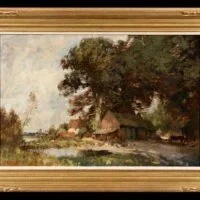A Barnyard in Norfolk by Edward Brian Seago



A Barnyard in Norfolk by Edward Brian Seago
Edward Seago was an English artist who mostly painted oils and watercolours. He travelled widely during his life starting from the 1930s when he joined a circus to Venice. He also visited Northern France, Holland, Portugal, Hong Kong, Antarctica and Africa.
DIMENSIONS: (unframed) 20.0 x 30.0 ins/ 50.8 x 76.2 cm
SIGNATURE: Signed ‘Edward Seago’ (lower left)
MEDIUM: Oil on board
Price: £65,000
Description
Born in Norwich, Edward Seago lived most of his life in East Anglia, settling in 1945 at Ludham on the Norfolk Broads. It is in the enduring relationship Seago forged with his native landscape that his most prominent inspiration was derived; in the rolling terrain and wooded slopes of Norfolk and Suffolk’s wild expanses.
Provenance
(with) Richard Green
Private Collection, United States
Biography
Seago was born in Norwich, to a family of Coal Merchants. He attended Norwich School, and never received any formal artistic training. He taught himself to paint, although received advice from the acclaimed equestrian painter Alfred Munnings. The boy’s talent was quickly noticed, and he won a prize for drawing at the age of 14 from the Royal Drawing Society.
This influenced his decision to make a career as a painter, despite his parents’ disapproval. Seago took most of his inspiration from the French Impressionists, and tried to emulate their technique of painting ‘en plein air.’ The artist was unable to fight during the Second World War, due to heart problems, but was commissioned as a Second Lieutenant in the Royal Engineers, and was employed to develop camouflage techniques. He continued to paint during the War, and gave a lot his pictures away to fellow soldiers.
Seago was popular as an individual and as an artist. His admirers included the Aga Khan III, who was an avid patron of the artist’s landscape paintings, as well as the British Royal Family. Those who wished to buy one of Seago’s paintings had to queue at his exhibitions, with the exception of the late Queen Mother. It is known that the Queen Mother bought so many of Seago’s paintings that the artist routinely gave her two a year – for her birthday and at Christmas. Prince Philip also invited Seago on a tour of the Antarctic in 1956, and the artist’s subsequent paintings still hang at Balmoral.
Seago also made the solid silver statue of St George slaying the Dragon, which serves as an automobile mascot for any state limousine in which Queen Elizabeth is travelling. The mascot can be transferred from car to car.
The artist died of a brain tumour at the start of 1974. In his will, he requested that almost a third of his large collection of paintings be destroyed; as he considered them to be of inferior quality. Since his death, Seago’s work has continued to be exhibited and collected widely, and in 2008, Sky Arts made a television series about his life